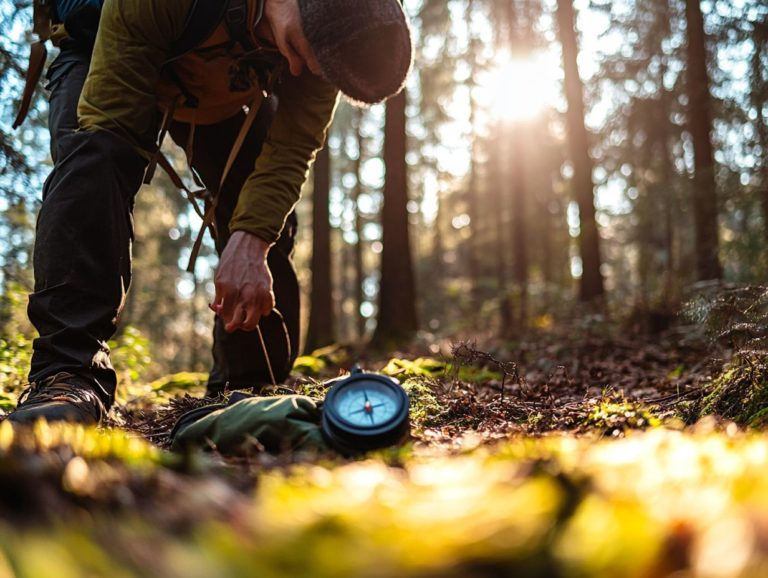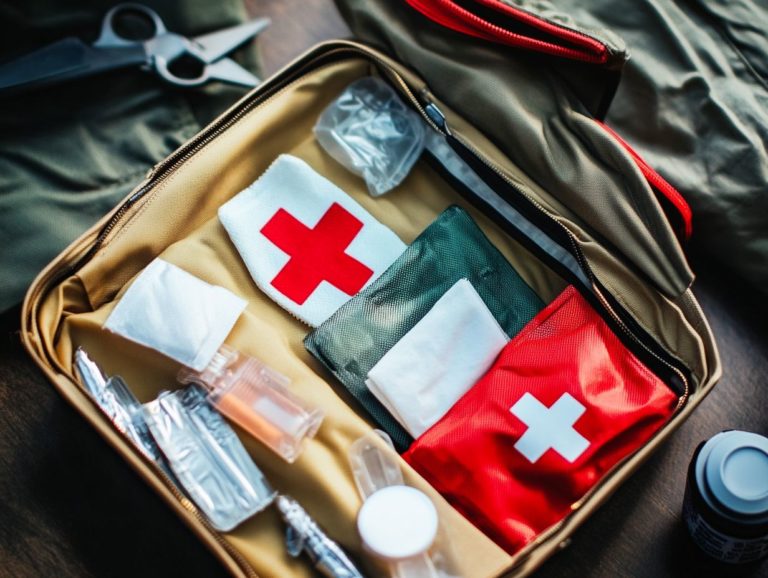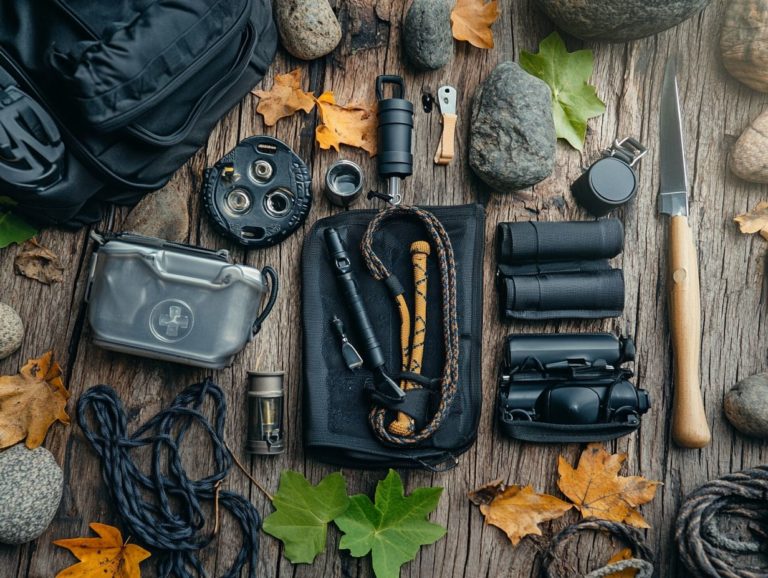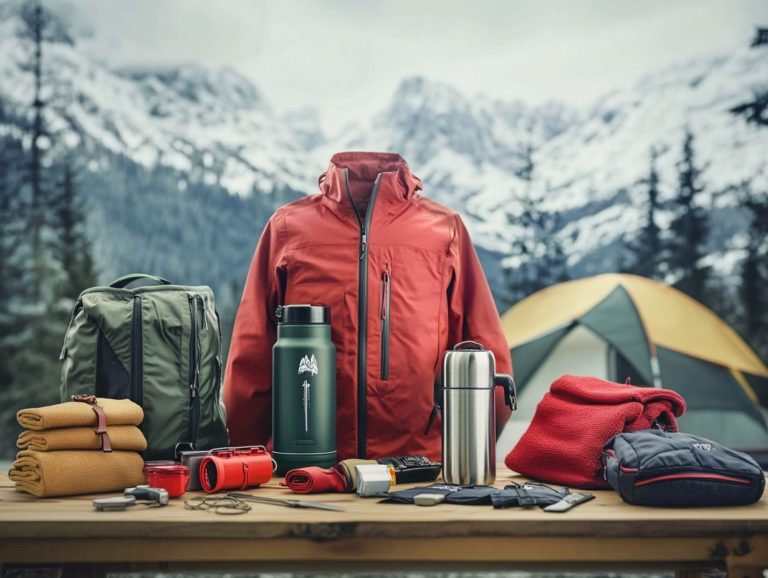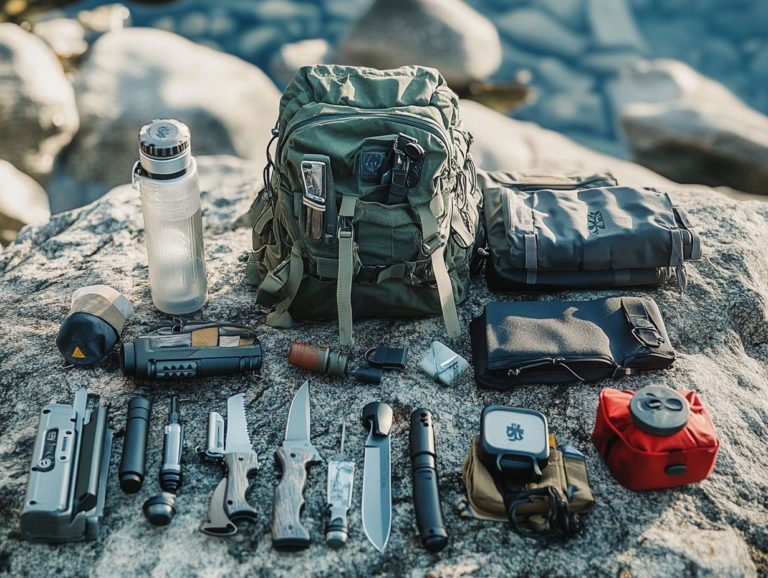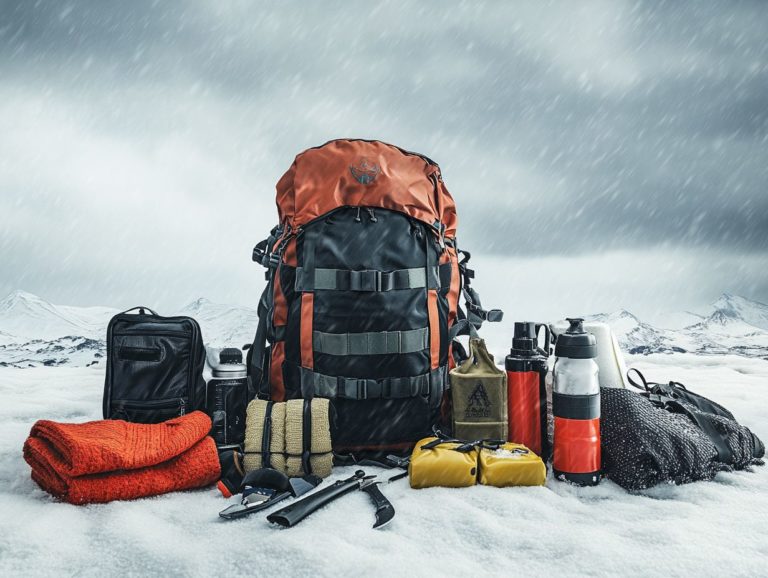Survival Gear for Young Explorers
When it comes to exploring the great outdoors, preparation is paramount especially for young adventurers like yours.
Whether it s a weekend camping trip or a day hike, having the right survival gear can truly make all the difference. This article outlines essential items every young explorer should pack, from appropriate clothing and sturdy footwear to navigation tools and first aid kits.
It also delves into important factors to consider when selecting gear and highlights common mistakes to avoid, ensuring your young adventurer is fully equipped for any escapade.
Equip your young adventurer with must-have skills to stay safe and make the most of their journey!
Contents
- Essential Tips for Young Explorers!
- 1. Essential Clothing and Footwear
- 2. Navigation Tools
- 3. Shelter and Sleeping Gear
- 4. Fire-Making Tools
- 5. Water Purification and Storage
- 6. First Aid Kit
- 7. Emergency Food Supply
- 8. Multi-Tool
- 9. Lighting Equipment
- 10. Communication Devices
- 11. Personal Protection Gear
- 12. Survival Manual or Guide
- 13. Hygiene and Sanitation Items
- 14. Repair and Maintenance Tools
- 15. Entertainment and Comfort Items
- What Are the Most Important Factors to Consider When Choosing Survival Gear?
- How Can One Prepare for Different Scenarios and Environments?
- What Are the Common Mistakes to Avoid When Packing Survival Gear?
- Frequently Asked Questions
- What is survival gear for young explorers?
- Why is survival gear important for young explorers?
- What are some examples of survival gear for young explorers?
- How should young explorers choose their survival gear?
- Can young explorers use adult survival gear?
- Where can I purchase survival gear for young explorers?
Essential Tips for Young Explorers!
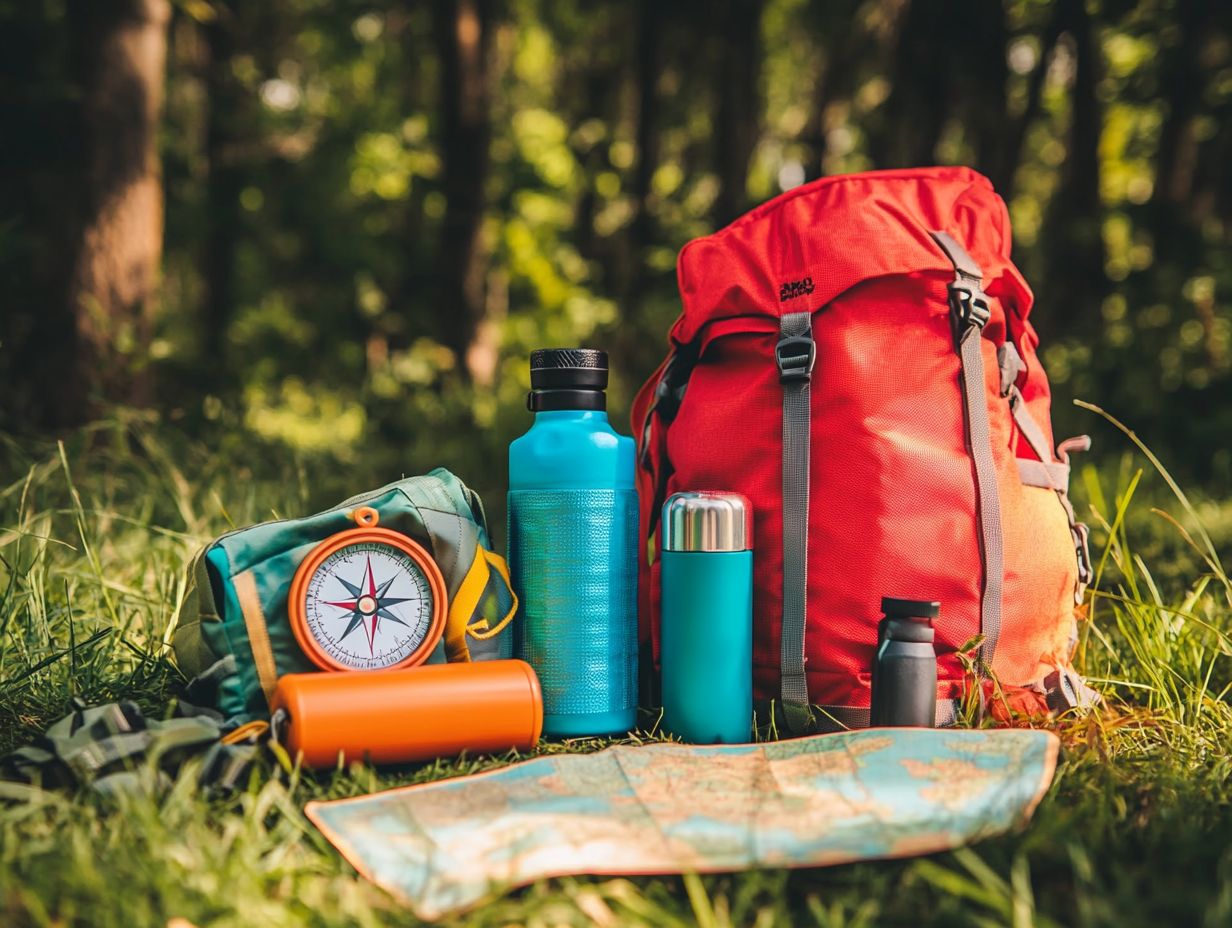
- Always have essential clothing and footwear suitable for the environment and weather conditions.
- Navigation tools are crucial for staying safe and finding your way in unfamiliar territory.
- A well-stocked first aid kit is a must-have for any young explorer’s survival gear.
1. Essential Clothing and Footwear
When you’re preparing for emergency situations, selecting the right essential clothing and footwear is crucial. The right gear can mean the difference between comfort and danger, especially in adverse weather conditions.
Items like thermal space blankets and moisture-wicking fabrics materials that pull sweat away from the skin to keep you dry are your best friends for insulation and protection. Durable footwear can enhance your mobility in challenging terrains. Proper clothing should not only keep you warm and dry but also allow for ease of movement, which is vital when situations get complicated.
Understanding layering can save you from discomfort or danger in extreme climates. In colder climates, base layers made from merino wool or synthetic fabrics efficiently wick moisture away from your skin, while mid-layers like fleece jackets trap the warmth you need. In warmer conditions, lightweight, breathable materials become essential for keeping your body cool and dry. Don t forget to bring an emergency thermal space blanket for added warmth.
For footwear, opt for options with sturdy soles and excellent ankle support, perfect for trekking over uneven ground to ensure balance and prevent injury. Water-resistant boots can be invaluable in wet conditions, helping you keep your feet dry and comfortable during prolonged outdoor activities.
Navigation tools are essential survival equipment that enable you to find your way in the wilderness. A reliable compass can guide you through uncharted territories and keep you on track during critical situations. Understanding how to use these tools effectively can significantly enhance your chances in survival scenarios, especially when technology lets you down.
Honing your map-reading skills is also crucial. This ability allows you to interpret land features and plan your routes with precision. Familiarity with the terrain can prevent disorientation and minimize the risk of dangerous navigation errors.
Developing your navigation skills involves practicing these techniques in varied environments, which will bolster both your confidence and competence. Errors in navigation can lead to dire consequences, particularly in remote areas where resources are limited. Therefore, mastering these tools is essential for increasing your chances of survival and ensuring a safe return home.
3. Shelter and Sleeping Gear
Creating a safe and secure shelter is fundamental to your survival gear. It acts as your shield against harsh weather and wildlife.
An emergency sleeping bag can be a lifesaver, providing essential warmth during critical nights spent outdoors. It’s vital to understand the options available, from portable tents to makeshift shelters.
This knowledge allows you to adapt seamlessly to different environments and weather conditions. Among these options, pyramid tents strike an excellent balance between stability and portability.
Their design is perfectly suited for effective wind resistance, which is crucial when the weather throws you a curveball. On the flip side, emergency blankets are lightweight and packable, delivering immediate warmth when temperatures take an unexpected dip.
When selecting sleeping gear, it s important to assess your surroundings consider factors like wind exposure, moisture levels, and potential insect encounters. This evaluation will guide you in choosing the right materials that provide both comfort and protection.
Making the right choice can greatly enhance your safety and overall experience during outdoor adventures.
4. Fire-Making Tools
Fire-making tools are essential in your survival arsenal, serving not just for warmth, but also for cooking and signaling for help when the stakes are high. Having effective fire-starting supplies, like waterproof matches or a DIY fire starter, can truly be a lifesaver in those critical moments.
Mastering the art of fire-making not only boosts your chances of survival but also elevates your comfort and morale when facing challenging circumstances.
You have a plethora of options at your disposal, from flint and steel to magnesium fire starters or even modern lighters, allowing you to choose what best fits your needs. Each tool offers unique advantages think of the reliability of flint sparks versus the convenience of a butane lighter.
If you’re feeling inventive, DIY techniques such as cotton balls soaked in petroleum jelly or egg cartons filled with wax can create effective fire starters while also embracing eco-friendly practices.
Understanding how to maintain a sustainable fire is vital. By selecting the right fuel and managing airflow, you ensure that warmth and light are preserved for extended periods an essential aspect in both survival situations and delightful outdoor gatherings.
5. Water Purification and Storage
Water purification and storage are essential elements of your survival gear, ensuring you have access to safe drinking water during emergencies. Reliable water purifiers and filters can transform potentially contaminated sources into life-sustaining hydration.
By understanding different methods of water purification, you significantly increase your chances of survival in the wilderness. Methods like activated carbon filtration not only clean the water but also make it taste great essential for any outdoor adventure!
Chemical treatments such as iodine or chlorine tablets neutralize pathogens in the water. Beyond purification, proper storage solutions like collapsible water containers play a crucial role in maintaining a safe water supply.
These containers are not only convenient for transport but also prevent contamination, making them ideal for your outdoor adventures.
Learning to identify safe water sources, such as moving streams or clear lakes, protects you against potential hazards. Each of these components contributes to a comprehensive strategy for ensuring access to clean drinking water when it matters most.
6. First Aid Kit
A well-stocked first aid kit is a must-have item for your outdoor adventures, crafted to tackle injuries and medical emergencies that might crop up. Having the right supplies at your fingertips can be vital in those tricky moments when professional medical assistance isn t just a phone call away.
Comprehensive first aid kits generally include must-have items like bandages, antiseptics, and specific medications. They also include travel toothbrushes tailored for common ailments you might face in the wild.
You should also include items like:
- gauze pads
- adhesive tape
- scissors
- tweezers
- a digital thermometer
These tools are crucial for effectively managing a variety of injuries or illnesses. A first aid manual is a must-have; it could save a life in emergencies! Regularly checking and updating your kit is essential, as expired medications or depleted supplies can make it utterly ineffective when you need it most.
Ensuring that every item is in working order not only boosts your safety but also instills confidence in your ability to tackle emergencies with efficiency.
7. Emergency Food Supply
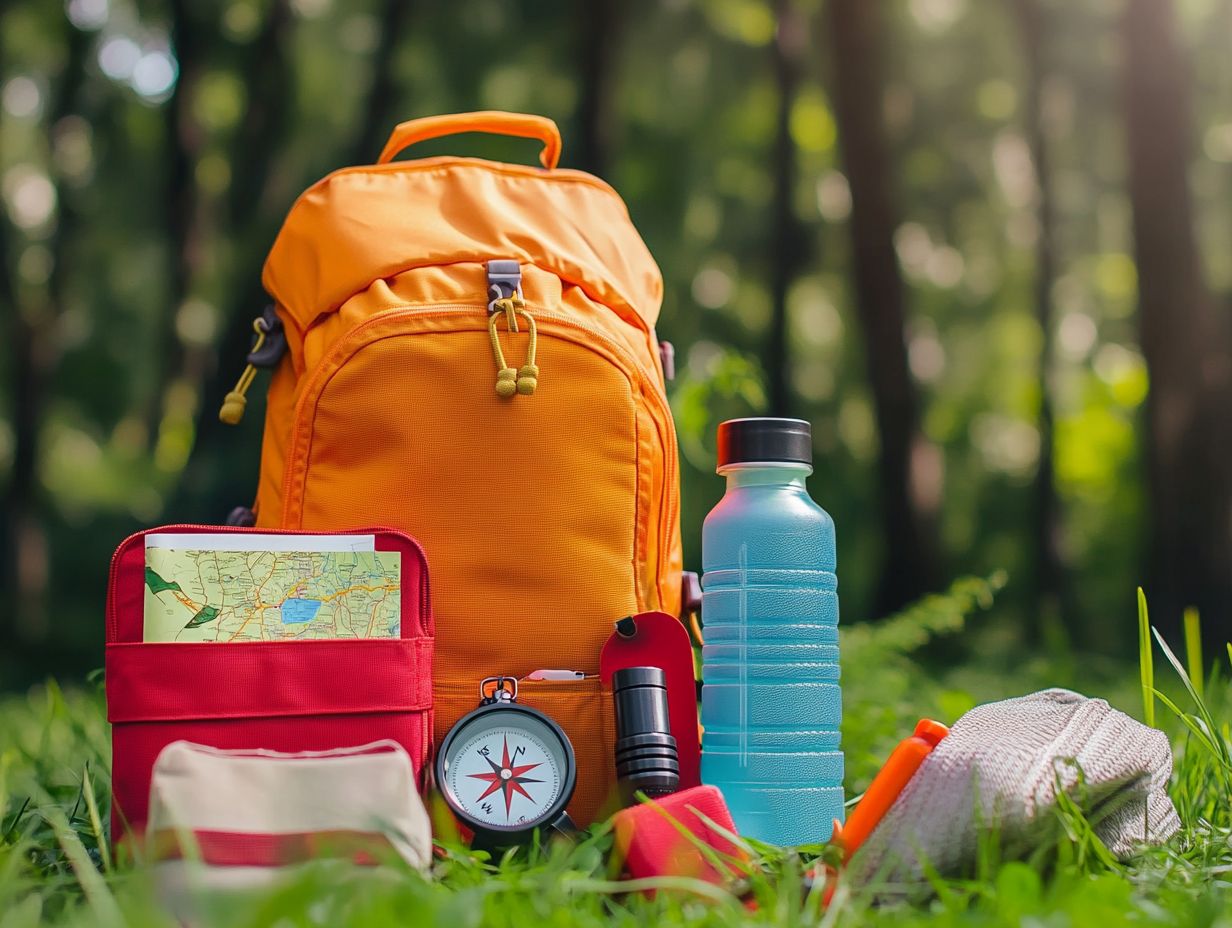
Having a reliable emergency food supply? That’s a game-changer! It ensures you have the nourishment necessary to maintain your energy levels.
Options like dehydrated camping food and canned meats are not only incredibly convenient but also boast impressive shelf lives. Choosing the right foods will keep you fueled and ready to tackle any challenges that come your way.
It’s essential to select foods with high nutritional value, as they provide not just energy but also vital vitamins and minerals that support your overall health during stressful times. Freeze-dried meals and granola bars are excellent examples; they require minimal preparation and are built to last.
When packing these items for quick access, consider using lightweight, resealable bags or containers. Organize them by meal type or duration, ensuring everything is easily accessible in your emergency kit.
This thoughtful arrangement not only maximizes weight efficiency but also allows for swift meal selection when you truly need it.
8. Multi-Tool
A reliable multi-tool a gadget that combines multiple tools in one is one of the most versatile pieces of survival equipment you can have. It provides essential tools and supplies for a variety of tasks in emergency situations.
From cutting and screwing to opening cans, a quality multi-tool can significantly enhance your readiness for unexpected challenges. With this tool at your disposal, you can streamline tasks and reduce the need to carry multiple items.
When selecting a multi-tool, it’s crucial to consider features such as durability, ensuring that the tool can withstand harsh environments and heavy use. Functionality is another key aspect; look for tools that include pliers, screwdrivers, and blades, offering a comprehensive solution for various tasks.
Ease of use matters significantly; a well-designed multi-tool should allow you quick access to its features without complicated mechanisms. For instance, tools like the Leatherman Wave+ are praised for their robust design and well-rounded functionality, making them ideal for everything from wilderness survival to everyday repairs.
9. Lighting Equipment
Lighting equipment is crucial in survival scenarios, providing essential sources of illumination for navigation, signaling, and safety. Options like LED flashlights and lanterns, along with spare batteries, keep you visible and oriented after dark. A hand-crank radio in your lighting gear enhances your ability to stay informed and connected during emergencies.
When selecting lighting equipment, weigh the advantages and disadvantages of each type. LED flashlights are energy-efficient and long-lasting, ideal for extended use, though they often have a higher initial price tag. In contrast, traditional incandescent lanterns provide warmth but consume more power and have shorter lifespans. Include backup power solutions, like solar chargers or extra batteries, since losing access to light can compromise your safety.
Using lighting effectively aids in navigation and serves as a signaling mechanism for rescue. In various situations, whether setting up camp or facing an emergency, knowing how and when to use different lighting sources significantly impacts your safety and overall success in survival scenarios.
10. Communication Devices
Effective communication devices are essential for staying in touch and ensuring safety in survival situations. A hand-crank radio provides crucial information and updates, while satellite phones keep you connected in remote areas. The right communication tools enhance your chances of rescue and survival.
Also, personal locator beacons (PLBs) are invaluable, sending distress signals to satellites over vast distances. Two-way radios are perfect for short-range communication, especially in team settings where immediate coordination is key.
Before any adventure, ensure your devices are charged and operational. Emergencies often strike unexpectedly!
By prioritizing reliable communication methods, you position yourself to call for help when needed and receive vital updates guiding your decisions in critical situations.
11. Personal Protection Gear
Personal protection gear is essential for shielding yourself from environmental hazards and wildlife encounters during survival situations. Items like insect repellent fend off bites and illnesses, while durable clothing acts as a barrier against cuts and scrapes on rugged adventures. Having the right protective gear keeps you safe and ready for adventure!
Consider including high-quality gloves, sturdy footwear, and headgear designed to block harmful UV rays in your survival toolkit. Choose materials that emphasize breathability, durability, and weather resistance. Regular maintenance cleaning and repairing damages is crucial for optimal performance over time.
Storing these items properly when not in use extends their lifespan, making every adventure not just safer but also more enjoyable.
12. Survival Manual or Guide
A survival manual is your lifeline in emergencies, providing essential survival skills. With a reliable guide, your decision-making skills in the wild will improve. This invaluable resource includes tips on first aid, navigation, and resource management, making it a must-have in your survival gear.
It offers insights that can be life-saving, such as identifying edible plants, constructing shelters, starting fires, and signaling for help skills vital in life-threatening scenarios. When choosing a survival manual, consider the specific environments you may encounter, whether wilderness survival, urban emergencies, or disaster preparedness.
Explore manuals like the “SAS Survival Handbook” by John Lofty Wiseman, covering a broad spectrum of survival skills, or “Bushcraft 101” by Dave Canterbury, focusing on wilderness conditions. These guides deliver practical advice and cultivate the mindset required to tackle unforeseen challenges with resilience.
13. Hygiene and Sanitation Items
Hygiene and sanitation items are often overlooked, yet they are vital components of your survival gear. Ensuring health and cleanliness in challenging environments is crucial. Essentials like travel toothbrushes and sanitation wipes help you avoid infections and stay safe!
Consider including biodegradable soap, hand sanitizers, and a compact first aid kit stocked with antiseptic wipes and ointments. These items keep you clean and play a critical role in treating minor injuries, which can escalate without proper care.
When you venture into the wilderness, maintain a routine. Wash your hands before meals and use separate cloths for personal hygiene to minimize contamination. Remember, a clean campsite is essential; it reduces the risk of attracting unwanted wildlife. This ensures a safer and healthier outdoor experience.
14. Repair and Maintenance Tools
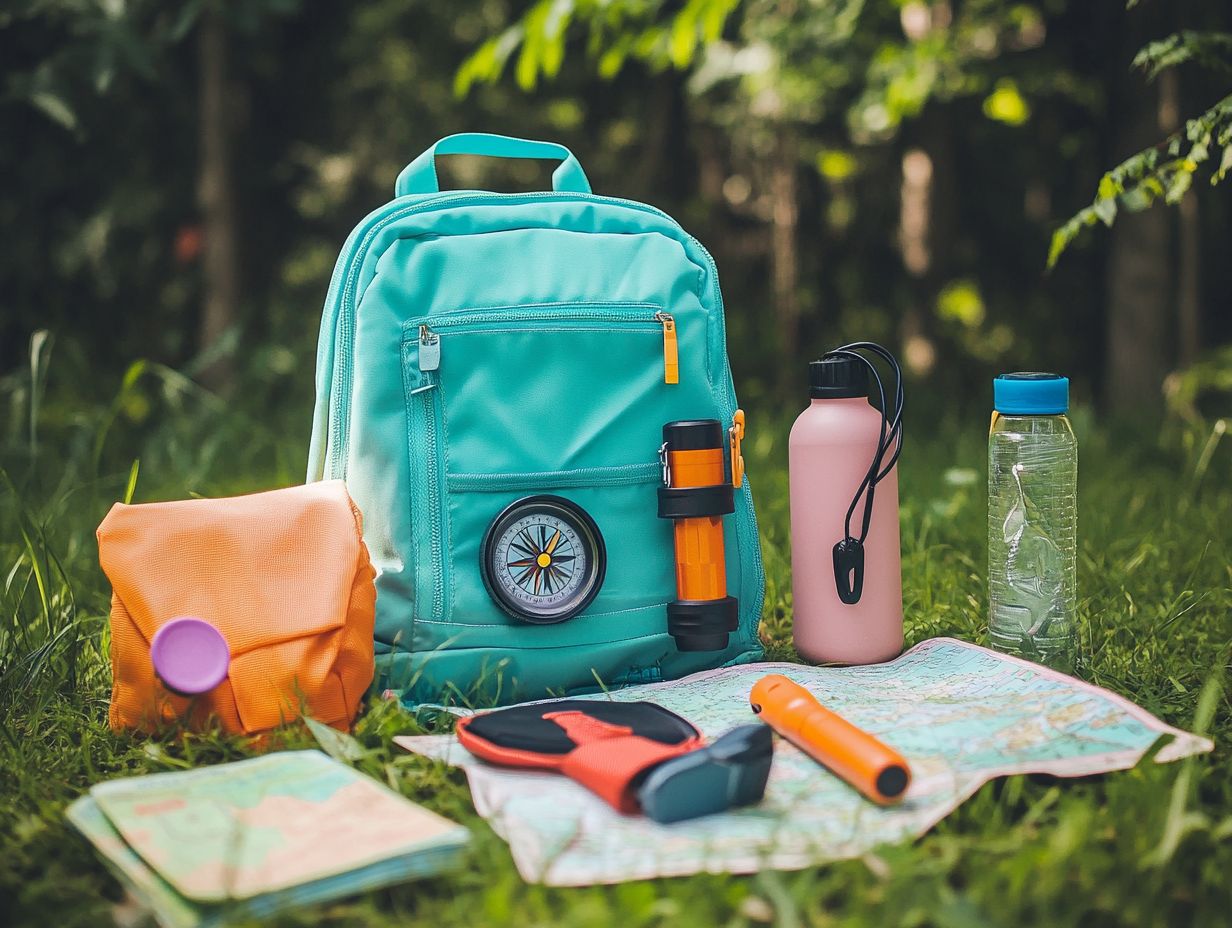
Repair and maintenance tools often go unnoticed in survival equipment, but they are important for keeping your gear in top shape. Having the right tools at your disposal can make a significant difference during unexpected challenges.
From a basic sewing kit to versatile multi-tools, these items extend the lifespan of your gear and bolster your chances of survival. In survival scenarios, the ability to make quick repairs can mean the difference between safety and vulnerability.
Items like duct tape, paracord, and a dependable set of pliers become invaluable. They enable you to tackle issues from patching torn clothing to securing loose equipment.
When you choose these tools, consider their weight, versatility, and durability. Ensure they fit comfortably in your pack without weighing you down. Opt for multi-functional tools to maximize space and serve multiple purposes.
Regular practice with these tools builds your confidence and readiness, preparing you to handle unforeseen repairs as they arise.
15. Entertainment and Comfort Items
Entertainment and comfort items are essential for boosting your morale during extended survival scenarios. Incorporating books, playing cards, or a small blanket offers you psychological relief, helping you navigate challenges.
Choosing the right options is key. Lightweight choices ensure that your pack remains manageable. Think about selecting small, portable games that you can enjoy solo or with others dice or travel-sized puzzles work wonders.
Downloading audiobooks or podcasts on your device serves as an excellent source of distraction and enjoyment, transporting you away from the demands of your situation.
A compact hammock can double as both a comfort item and a relaxation spot, creating a little oasis that promotes a sense of normalcy. By integrating these carefully chosen elements, you foster not just physical survival but also nurture your emotional well-being during trying times.
Plan your gear wisely and practice repairs regularly to enhance your experience in the great outdoors!
What Are the Most Important Factors to Consider When Choosing Survival Gear?
Choosing the right survival gear is an important choice. It greatly affects your safety and success during outdoor adventures. By understanding the essential gear needed for specific conditions and scenarios, you ll significantly enhance your preparedness.
Consider factors like weight, durability, and the unique demands of your environment as you make your selections. This way, you ll ensure that the gear you pack is functional and reliable.
Think about the terrain you ll be navigating whether it s a dense forest, an arid desert, or a snowy mountain. This will greatly influence your selections. In wooded areas, consider items like a bush knife or a folding saw.
For example, minimalist gear might be perfect for light backpacking in temperate climates. In contrast, more robust equipment is necessary for extreme weather conditions.
Your personal needs are also crucial. If you have specific health requirements or varying skill levels, choose gear that accommodates those aspects, including do-it-yourself methods for creating items like a DIY fire starter. For more comprehensive options, check out the top 10 survival gear for wilderness adventures. Effective packing strategies will enhance your safety and efficiency in any survival situation.
How Can One Determine the Quality and Durability of Survival Gear?
Determining the quality and durability of survival gear is essential for ensuring reliable performance in emergencies. Assess materials, such as survival knives, brand reputation, and user reviews to gain valuable insights into the longevity of the gear. Understanding these factors helps you avoid investing in low-quality items that may fail you when it matters most.
It s vital to examine the specifications of the materials used. Look for their resistance to weather conditions and wear, including water filter systems. Certifications from recognized organizations can further substantiate the reliability of these products, assuring you that they meet industry standards.
Consider warranty options, as they provide peace of mind and reflect a manufacturer’s confidence in their product. When researching different brands, utilizing comparison websites and forums can lead you to a more informed decision.
Look for lists of top-selling survival gear to ensure you’re considering the best options. This approach allows you to assess both pricing and user experiences, helping you uncover any potential shortcomings of specific items.
What Are the Must-Have Items for a Young Explorer’s Survival Kit?
For a young explorer like you, having a well-rounded survival kit, such as the Be Prepared Boyscout Survival Kit, is crucial. The must-have items should cater to your specific needs while ensuring safety and comfort in various conditions.
Essential survival gear includes basics like a First Aid kit, water purification options, such as a brown bag filter, and suitable clothing, all tailored to your age and experience level.
Including a multi-tool or pocket knife gives you the ability to tackle minor challenges. However, responsible use and supervision are important. A portable flashlight is also vital for navigating low-light situations, while compact snacks will keep your energy up during your adventures.
When packing, consider the weight and size of each item, such as metal pots and survival cooking kits, to ensure the kit remains manageable for your hands. Learning how to use each piece not only builds confidence but also instills a sense of responsibility, preparing you for the unexpected in the great outdoors.
How Can One Prepare for Different Scenarios and Environments?
Preparing for different scenarios and environments is crucial for effective survival planning. Understanding the unique challenges of various settings whether mountains, forests, or deserts enables you to select the most suitable survival gear.
By tailoring your kit to the specific environment, you enhance your adaptability and readiness for unexpected situations. For instance, if you find yourself in a mountainous region, sturdy trekking poles and a high-quality multi-tool can be invaluable.
These tools aid navigation and allow you to manage unexpected repairs. In a dense forest, a reliable compass and GPS device will help you avoid getting lost, while a good sleeping bag keeps you warm during cooler nights.
In arid desert conditions, water purification systems, including Ziploc Baggie methods for storing water, and lightweight, breathable clothing become essential to combat heat and dehydration. Carefully evaluate these environmental factors to craft a personalized survival kit that perfectly aligns with your specific needs.
What Are the Common Mistakes to Avoid When Packing Survival Gear?
Avoid common mistakes when packing survival gear. Overlooking crucial items or overpacking can lead to stress in emergencies.
Regularly assess what you have versus what you truly need in your kit. Your priorities may shift based on the environment or specific plans.
Creating a checklist helps minimize oversights. Practicing your packing under timed conditions can enhance both your efficiency and confidence.
Engaging in regular reviews allows you to make updates based on personal experiences. This reflection enables you to develop a more tailored packing strategy, ensuring you re always ready for whatever comes your way.
Frequently Asked Questions
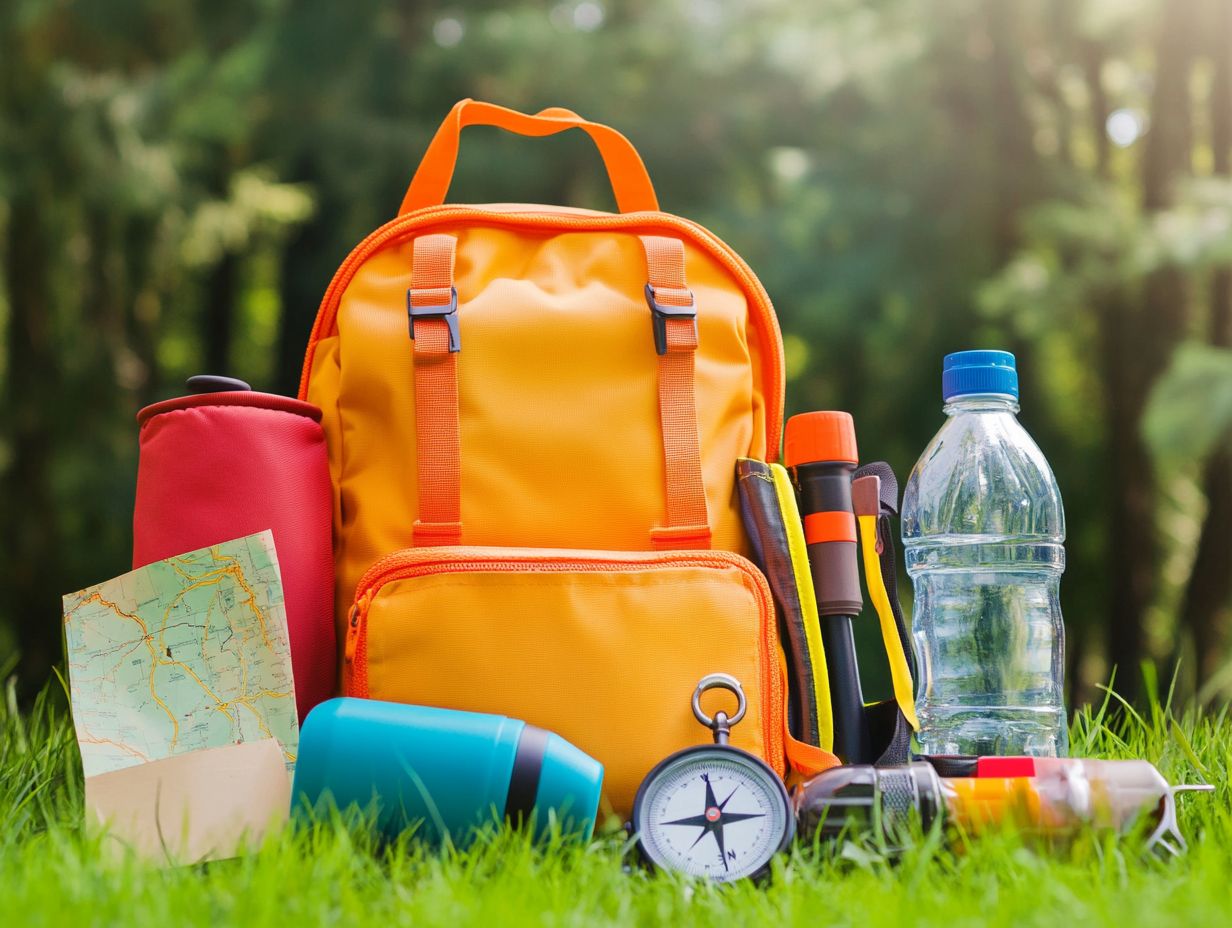
What is survival gear for young explorers?
Survival gear for young explorers is a collection of essential items and tools designed to help children and teenagers survive in outdoor environments.
Why is survival gear important for young explorers?
Survival gear is important for young explorers because it helps them stay safe in potentially dangerous situations, such as getting lost or encountering extreme weather.
What are some examples of survival gear for young explorers?
Examples include a first aid kit, a compass, a multi-tool, a water filtration system, a fire starter kit, and a whistle.
How should young explorers choose their survival gear?
Choose survival gear based on specific needs and the type of environment you will explore. Consider factors like weather, trip length, and potential hazards.
Can young explorers use adult survival gear?
Some adult survival gear may be suitable, but ensure it is appropriate for their size, strength, and skill level. Teach children how to use the gear safely!
Where can I purchase survival gear for young explorers?
You can purchase survival gear at outdoor and camping stores, online retailers, and some department stores. Read reviews and compare prices before making a purchase.

